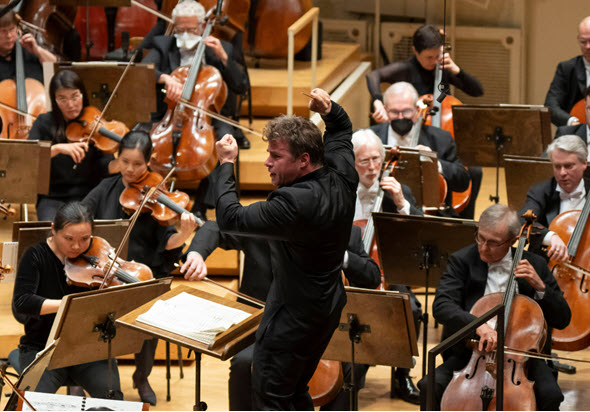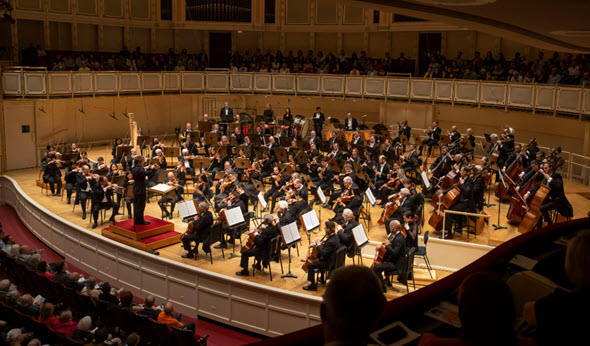With a transcendent Mahler Ninth Symphony, Czech rises in CSO directorship sweepstakes

Conductor Jakub Hrůša basked in audience accolades and musicians’ smiles after his Mahler. (Todd Rosenberg photos)
Commentary: Jakub Hrůša, who conducts two Chicago Symphony programs next season, led a magnificent Mahler performance.
By Lawrence B. Johnson
The big news at Orchestra Hall this week is the return of Riccardo Muti for the first of his two final programs as music director of the Chicago Symphony Orchestra. But hardly less compelling, even now, is the quest for his successor. If the lineup of guest conductors for next season looks like an audition roster, one name stands out if only because it occurs twice: Jakub Hrůša, who will lead consecutive programs in March 2024. Based on the nuanced and illuminating Mahler Ninth Symphony he conducted with the CSO this past weekend, one might even see the 41-year-old Hrůša as the frontrunner.
The Czech maestro is music director-designate of London’s Royal Opera, Covent Garden, effective in 2025, and currently music director of the Bamberg (Germany) Symphony, as well as principal guest conductor of the Czech Philharmonic. He has appeared several times with most of the major orchestras of Europe and the U.S. Hrůša’s account of the Mahler Ninth on June 8 bespoke a conductor of extraordinary insight, finesse and all-around authority.
Mahler had already been diagnosed with the heart disease that would take his life when he composed the Ninth Symphony in 1909-10. He died the next year without ever hearing this vast summation of life in four episodes – perhaps better called chapters than movements – that sprawl across some 85 minutes. While it probably does amount to a valediction, the Ninth is not strictly a leave-taking, any more than its similarly existential predecessor “Das Lied von der Erde” was a last gesture. After the Ninth, Mahler plunged immediately into the ultimately unfinished Tenth.
Still, whether one frames it as death or dying or the consummation of life, mortality is very clearly the subject of the Ninth Symphony. It is profoundly philosophical and reflective, something of a spiritual tone poem in the form of a symphony. It begins and ends with broad slow movements, the first a weary rumination and the last an expansive letting go in utter quiescence. In between, life happens: a lusty, rigorously elaborated laendler followed by a “burlesque” rondo that finds Mahler in his familiar mode of bizarre contrasts and careening surrealism.
All this portrayed in the carefully brushed inflections of a master at orchestral painting. Indeed, inflection was the byword of both Hrůša ‘s eloquent concept of the Ninth Symphony and the CSO’s sweeping performance.
The four tableaux of the Ninth Symphony have always put me in mind of Faust, or a similarly worldly figure (even Mahler himself), at the end of his days: alone in the wee hours, pensive, resigned. In this broad sense, Hrůša spun out the work’s opening movement, with its halting rhythms and wearily descending intervals, as a moody contemplation expressive not of tragedy but of inevitability. The conductor’s patience and precision allowed the music to well and flow and slowly swirl, doubling back upon itself: the construct of a mirror that reflected a myriad of perspectives. And the orchestra captured that imagery in delicate suggestions of weight and substance.
Mahler returns to the throbbing world with the second-movement laendler, a country dance that’s pounded out with a heavy pulse amid sundry digressions. As everywhere throughout Mahler’s vast symphonies, counterpoint plays a central role in the musical structure, charging the laendler with irrepressible vitality. The careful layering of voices and the internal rhythmic impulse afforded a stunning display of the CSO strings and winds in their close-knit, sparkling ensemble.
But it was the wild brilliance of the third-movement burlesque that took the performance over the top as an exercise in overt collective virtuosity. This gleamy, rowdy rondo – life as a cabaret – also afforded a clear picture of Hrůša’s conducting style: controlled, exact, engaged and expressive but largely free of histrionics. He does not over-conduct. If he sometimes goes with the extreme moment, well, even Muti’s feet leave the podium from time to time.
The expansive, slow-moving finale of the Ninth Symphony invites comparison with the “Abschied,” or farewell, that crowns “Das Lied von der Erde” (The Song of the Earth). Essentially, both works engage that same lyric of life and both arrive at similar perspectives on its expiration: What must be shall be. While no one sings a text in the Ninth Symphony, its finale is nothing less than a gentle poem like that of “Das Lied,” and it ends in the same spirit of “ever and ever.” Surely, the becalmed course of the Ninth’s finale is the hardest music in the symphony to sustain, to conduct. This is where Hrůša made his greatest impression, summoning music of radiance, grandeur and ravishing intensity. For the amply arrayed CSO, it was a magnificent conclusion.



